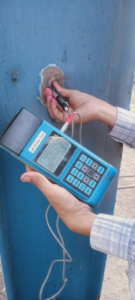Portable Hardness Testing
Portable Hardness Testing by Leeb rebound Hardness Tester
Conventional hardness testers, like Rockwell, Brinell or Vickers machines, require the test piece be brought to the testing device; but this is not always possible. Portable testing devices have been developed that permit in-situ hardness measurements thus offering quick and economical supplements to conventional, stationary testing machines. There are two different physical methods particularly recognized in the practical field and which are accepted tools for many applications.


Introduction
What is “hardness”?
With regard to metals, hardness has always been a subject of much discussion among technical people, resulting in a wide range of definitions. Hardness properties include such varied attributes as resistance to abrasives, resistance to plastic deformation, high modulus of elasticity, high yield point, and high strength, absence of elastic damping, brittleness or lack of ductility.
To a metallurgist, hardness is a material’s resistance to penetration. In general, an indenter is pressed into the surface of the material to be tested under a specific load for a definite time interval, and a measurement is made of the size or depth of the indentation.
Hardness is not a fundamental property of a material, but a response to a particular test method. Basically hardness values are arbitrary, and there are no absolute standards for hardness. Hardness has no quantitative value, except in terms of a given load applied in a specific, reproducible manner and with a specified indenter shape.
Static indentation tests in which a ball, cone or pyramid penetrates into the surface of the material being tested are widespread. The relationship of load to the area or depth of indentation is a measure of hardness, such as that found in common bench-top Brinell, Rockwell, Vickers or Knoop hardness testers.
The different methods and differently shaped indenters used by, for example, Brinell (HB) and Rockwell (HRC) produce dissimilar responses of the material under test. Conversion tables relating to e.g. HRC and HB values have to be determined empirically by experimental evaluation of a specific material’s hardness with the different test methods. There exists no mathematical equation to transfer measurements from one scale to another. To compare the hardness of two different samples, both must be measured using the same hardness scale, or a scale must be developed to convert from one measurement to the other.
The UCI Method
As in standard Vickers or Brinell hardness testing, the question as to the size of the test indentation in the material generated by a certain test load also arises in Vickers hardness testing according to the UCI (Ultrasonic Contact Impedance) method. However, the diagonals of the test indentation, which have to be known in order to determine the Vickers Hardness value, are not evaluated optically as usual, but the indentation area is electronically detected by measuring the shift of an ultrasonic frequency.
The Rebound method
Hardness testers using the Rebound method operate in a slightly different manner. Although the size of the test indentation generated is connected with the material hardness even in this case, it is indirectly measured via the loss of energy of a so-called impact body. A mass is accelerated to the surface of the test object and impinges on it at a defined speed, i.e. kinetic energy. The impact creates a plastic deformation of the surface, i.e. an indentation, due to which the impact body loses part of its original speed – or energy. It will lose more velocity when creating a bigger indentation on softer material. Technically, this principle of measurement is implemented by means of an impact body which has a spherical tungsten carbide tip and which is accelerated onto the test surface by spring force. The velocities after and before the impact are each measured in a non-contact mode.
Our Other Services
- Rebound Hammer
- Ultrasonic Pulse Velocity
- Half Cell Potentials
- Concrete Core
- Carbonation
- Cover Meter Survey
- Pile Integrity Test
- Pile Dynamic Test
- Bridge Load Test
- Slab Load Test
- Cross Hole Sonic Test
- In-Situ Metallography (Replica)
- Portable Hardness Test (Rebound & UCI Method)
- Expert Metallurgy Consultant For Site
- Pressure Vessel Inspection & Maintenance
- Condition Assessment
- Remaining Life Assessment
- Fitness For Service
- Pipeline Inspection & Maintenance
- Tank Inspection & Maintenance
- IBR/Non IBR Fabrication
- Structural Health Assessment / Structure Audit
- Reactor Inspection As Per Factory Act





